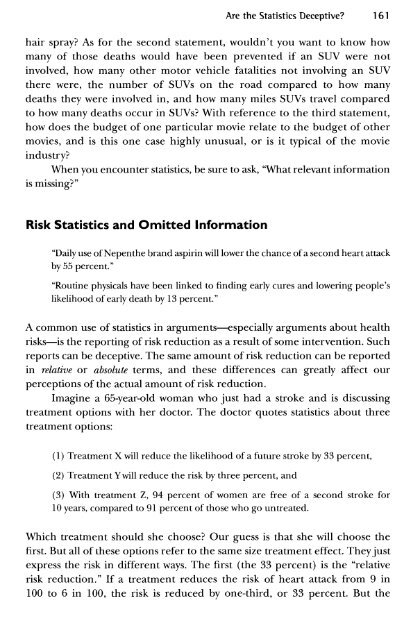Asking the Right Questions, A Guide to Critical Thinking, 8th Ed
Asking the Right Questions, A Guide to Critical Thinking, 8th Ed
Asking the Right Questions, A Guide to Critical Thinking, 8th Ed
You also want an ePaper? Increase the reach of your titles
YUMPU automatically turns print PDFs into web optimized ePapers that Google loves.
Are <strong>the</strong> Statistics Deceptive? 161<br />
hair spray? As for <strong>the</strong> second statement, wouldn't you want <strong>to</strong> know how<br />
many of those deaths would have been prevented if an SUV were not<br />
involved, how many o<strong>the</strong>r mo<strong>to</strong>r vehicle fatalities not involving an SUV<br />
<strong>the</strong>re were, <strong>the</strong> number of SUVs on <strong>the</strong> road compared <strong>to</strong> how many<br />
deaths <strong>the</strong>y were involved in, and how many miles SUVs travel compared<br />
<strong>to</strong> how many deaths occur in SUVs? With reference <strong>to</strong> <strong>the</strong> third statement,<br />
how does <strong>the</strong> budget of one particular movie relate <strong>to</strong> <strong>the</strong> budget of o<strong>the</strong>r<br />
movies, and is this one case highly unusual, or is it typical of <strong>the</strong> movie<br />
industry?<br />
When you encounter statistics, be sure <strong>to</strong> ask, "What relevant information<br />
is missing?"<br />
Risk Statistics and Omitted Information<br />
"Daily use of Nepen<strong>the</strong> brand aspirin will lower <strong>the</strong> chance of a second heart attack<br />
by 55 percent."<br />
"Routine physicals have been linked <strong>to</strong> finding early cures and lowering people's<br />
likelihood of early death by 13 percent."<br />
A common use of statistics in arguments—especially arguments about health<br />
risks—is <strong>the</strong> reporting of risk reduction as a result of some intervention. Such<br />
reports can be deceptive. The same amount of risk reduction can be reported<br />
in relative or absolute terms, and <strong>the</strong>se differences can greatly affect our<br />
perceptions of <strong>the</strong> actual amount of risk reduction.<br />
Imagine a 65-year-old woman who just had a stroke and is discussing<br />
treatment options with her doc<strong>to</strong>r. The doc<strong>to</strong>r quotes statistics about three<br />
treatment options:<br />
(1) Treatment X will reduce <strong>the</strong> likelihood of a future stroke by 33 percent,<br />
(2) Treatment Ywill reduce <strong>the</strong> risk by three percent, and<br />
(3) With treatment Z, 94 percent of women are free of a second stroke for<br />
10 years, compared <strong>to</strong> 91 percent of those who go untreated.<br />
Which treatment should she choose? Our guess is that she will choose <strong>the</strong><br />
first. But all of <strong>the</strong>se options refer <strong>to</strong> <strong>the</strong> same size treatment effect. They just<br />
express <strong>the</strong> risk in different ways. The first (<strong>the</strong> 33 percent) is <strong>the</strong> "relative<br />
risk reduction." If a treatment reduces <strong>the</strong> risk of heart attack from 9 in<br />
100 <strong>to</strong> 6 in 100, <strong>the</strong> risk is reduced by one-third, or 33 percent. But <strong>the</strong>



